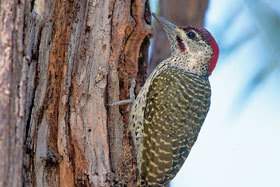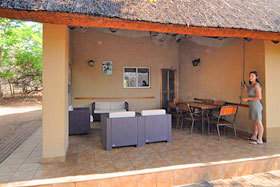
Birding Map of Kruger Park South-East Region
- The South-east
- Crocodile Bridge Area
- Crocodile Bridge to Sabie
- Lower Sabie to Skukuza
- Lower Sabie to Satara
- Crocodile Bridge to Malelane
- Crocodile Bridge to Skukuza
- Biyamiti Region
Skukuza Via The Bume or Randspruit Roads (S26 and H5)
These are interesting alternative routes between Crocodile Bridge and Skukuza through the mixed woodland areas of Bume River catchment area in southern central Kruger. The Randspruit road follows the route of the old Selati railway line.
Shortly after the turn-off from the main road to Lower Sabie is the site of a century-old trading store run by Sardelli the Greek. Sardelli was an infamous lowveld hustler who apparently brewed a liquor so toxic that it was rumoured to explode if dropped on the ground. A bluegum planted at the site over 100 years ago is one of the few exotic trees allowed in Kruger and has been spared the chainsaw because of its legacy. African Green-Pigeons are usually the dominant birds in the large Sycamore Fig trees that grow around the old store site.
West along the Randspruit or Bume Roads, the acacia thickets give way to mixed bushwillow and Marula woodlands. Gregarious flocks of Green Wood-Hoopoe* are common in southern Kruger, their cackling chorus echoing through the trees.
Skukuza Via The Bume or Randspruit Roads (S26 and H5)
These are interesting alternative routes between Crocodile Bridge and Skukuza through the mixed woodland areas of Bume River catchment area in southern central Kruger. The Randspruit road follows the route of the old Selati railway line.
Shortly after the turn-off from the main road to Lower Sabie is the site of a century-old trading store run by Sardelli the Greek. Sardelli was an infamous lowveld hustler who apparently brewed a liquor so toxic that it was rumoured to explode if dropped on the ground. A bluegum planted at the site over 100 years ago is one of the few exotic trees allowed in Kruger and has been spared the chainsaw because of its legacy. African Green-Pigeons are usually the dominant birds in the large Sycamore Fig trees that grow around the old store site.
West along the Randspruit or Bume Roads, the acacia thickets give way to mixed bushwillow and Marula woodlands. Gregarious flocks of Green Wood-Hoopoe* are common in southern Kruger, their cackling chorus echoing through the trees.
A good birding spot on the Bume Road (S26) is its meeting point with the Crocodile River Road at the Bume Weir. This is an intimate stretch of the river as it goes through a narrow channel with tall, riverine trees on either side with a raptor nest about 100 meters upstream. Look out around here for the White-winged Widowbirds* and Three-banded Plovers. Red-backed Shrikes are a common sighting in the thorn thickets during summer.
The nearby Gayisenga Water Hole on the S26 is a good place to spend some time, and a recommended detour is the short drive (S102) between the Bume and Randspruit roads as it crosses a number of watercourses surrounded by mixed woodland and thorn thickets. The S102 has two good birding spots quite close to each other - the Mpondo Dan and the Buffelsdoring Water Hole.
Magic Guarri is a noticeable tree in this area, particularly on the lower slopes. Other significant trees are the bushwillow species, Knob-thorns, leadwoods along the drainage lines, Greenthorn Torchwood (Ballonits) and Apple-leaf. The Brown Snake-Eagle like to nest in the larger acacias and Ebony Jackal-berry trees in Southern central Kruger.
Both the Bume and Randspruit roads join the S114 which is the main alternative route from Malelane to Skukuza.
The Central - South Road (S114) to Skukuza
 The S114 is usually reliable for woodpeckers and bush-shrikes because it is a dynamic woodland enviroment with lots of dead and decaying trees. Woodpeckers have a tapping rhythm that is species specific.
The S114 is usually reliable for woodpeckers and bush-shrikes because it is a dynamic woodland enviroment with lots of dead and decaying trees. Woodpeckers have a tapping rhythm that is species specific.
Each type of woodpecker taps to a different rhythm, signaling its territory to other birds. The loudest tapper is the Bearded Woodpecker. It is not as common as the Cardinal Woodpecker, which seeks out wasp larvae in the seed pods of the large-fruited Bushwillow. The Cardinal is sometimes joined in feeding parties by the Golden-tailed Woodpecker, which has a shrill scream, described by some as the sound of an old door squeaking on its hinges.
The noisy and conspicuous Tawny-flanked Prinia is common here - it has a plain chest and a jerky flight.
Renosterkoppies is part of a series of granitic inselbergs protruding in an eastern line across the southern lowveld floor. Among them is Shirimantanga (450m) where the ashes of Col James Stevenson-Hamilton were scattered after his death in 1957. North of Renosterkoppers, the mixed bushwillow woodlands give way to thorn thickets (See Around Berg-En-Dal and Mathkanyane and Renosterkoppies).
Generally in the more open areas of mixed woodland and grassland south of Skukuza there's a better than average chance of spotting the Black-bellied Bustard*. Other birds associated with this bush are Burchell's Coucal, Magpie Shrike* and Crowned Lapwing*, which is found in small flocks in the shorter grass.
Thorn Thickets dominate the landscape closer to Skukuza. Among them are tall, bushveld trees where raptors are often perched surveying the veld below them. Wahlberg's Eagle, the Bateleur, Lesser Spotted and Martial Eagles favour this terrain. The Martial is attracted to the high population of leguaans along the Sabie River.

Where to stay Around Crocodile Bridge

